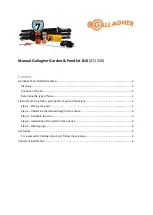
15
OPERATOR’S MANUAL
DOUBLE-ROTOR RAKES
DUO
4.9.2. Danger of wound, abrasion and damage of skin
Present when replacing working parts with sharp edges, cleaning the machine and removal of any
clogging and jams
.
For any repair and maintenance works always wear safety gloves.
4.9.3. Danger of liquid ejection out of hydraulics
When connecting hydraulic hoses to and from the tractor hydraulic connectors make sure, that
either tractor or mower hydraulics are pressure free.
When servicing hydraulic unit, always wear protective gloves and eyewear. Inspect hydraulic
hoses regularly.
NOTE:
Residual risk results from incorrect behavior of the machine's operator.
4.9.4. Bans
Bear in mind the following bans when operating the rakes:
❑
Do not unblock the rake, make any adjustments or repairs when the mower is operating.
❑
Never change the sequence of operation and maintenance works specified in the operator's manual.
❑
Never operate the rake when its working condition is poor or has safety guards damaged.
❑
Never get your limbs close to rake's rotating parts.
❑
During the rake's repair and maintenance works always comply with the descriptions included in
the operator's manual, while conducting them with the tractor drive disconnected.
❑
Prior to approaching any works, focus your attention solely on the tasks to do.
❑
Never operate the rakes being under influence of alcohol, drugs, or strong medicines.
❑
Wear clothing that is not too loose, nor too tight. Too loose clothing elements may be pulled in by
the machine's rotating parts.
❑
The rake cannot be operated by children nor handicapped people.
When describing residual risk, the rake shall be considered a machine, which until the moment of
production launching had been designed and manufactured in accordance with top technology level
actual as per the machine manufacture date.
NOTE:
There is possibility of residual risk if not complying with specified instructions
and bans.
When the risk of being exposed to noise cannot be avoided or eliminated by any
group protective means or organization of work, employer (operator) must:
1) provide the operator with individual means of noise protection, if the noise
level in work place exceeds 80 dB.
2) provide the operator with individual means of noise protection and supervise
its proper use, if the noise level in work place reaches or exceeds 85 dB.
















































